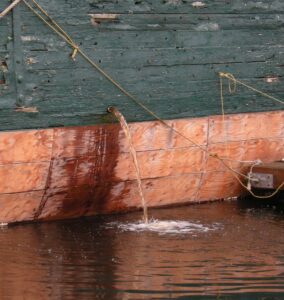Introduction to Bilge Management

Bilge water is a type of wastewater that accumulates in the lowest parts of a ship, known as the bilge. This area is the intersection of the ship’s bottom and the lower point of the interior hull.
Bilge water is a mixture of water, oil, grease, sludge, and other chemicals that collect in this area due to various shipboard operations and external sea conditions. It is an inevitable byproduct of the complex systems and machinery required for modern maritime operations.
How Oil Gets into Bilge Water
Oil can enter the bilge through several routes:
- Oil can leak from engines, hydraulic systems, and other oily equipment onboard. This is often due to wear and tear, imperfect seals, or system malfunctions.
- Accidental spills during the operation, maintenance, or refuelling of ship machinery.
- Detergents used to clean the engine room and other areas of the ship can pick up oil.
- Sea or rainwater that enters the ship can bring in oil from contaminated seas.
Importance of Managing Bilge Water Effectively
Managing bilge water effectively is crucial for several reasons:
Environmental Protection
Oil is a major pollutant that can have devastating effects on marine ecosystems, harming marine life, affecting bird populations, and damaging sensitive coastal habitats.
Safety
Overfilled bilges can create a risk of fire, especially if the bilge water is contaminated with oil.
Compliance with Regulations
International and national regulations, notably the International Convention for the Prevention of Pollution from Ships (MARPOL), set strict limits on the discharge of oil and bilge water. Failure to comply with these regulations can result in significant fines and legal action.
Operational Efficiency
Accumulated bilge water can affect the stability of the ship and increase fuel consumption. A well-maintained bilge water treatment system ensures the longevity and efficiency of onboard machinery.
The Importance of Responsible Bilge Management
Responsible management of bilge water is essential for alleviating environmental impacts. It involves preventing illegal discharges to ensure bilge water is treated appropriately on board before discharge or disposed of at dedicated facilities onshore.
What are the Regulations for Oily Discharge?
The Marine Environment Protection Committee (MEPC) mandates that all vessels of 400 gross tons or more, whose keel was laid or reached a similar stage of construction on or after January 1, 2005, must adhere strictly to the guidelines stipulated in MEPC.107(49) regulations.
This regulation is enforced worldwide, underscoring the international maritime community’s commitment to preventing marine pollution.
Non-compliance with these directives can lead to severe penalties, including fines exceeding $1 million and the detention of vessels.
This highlights the gravity with which marine pollution prevention is regarded on a global scale, reinforcing the imperative for vessels to operate within these environmental safeguards.
Advanced Technology Solutions
Employing technologies like oily water separators and monitoring systems to ensure compliance with legal thresholds for oil content in discharged bilge water.
How the SMART Bilge Oil Content Monitor Can Help
The SMART Bilge oil content monitor is an advanced technological solution designed to help prevent the discharge of oil into the sea.
It plays a critical role in ensuring compliance with the International Convention for the Prevention of Pollution from Ships (MARPOL) regulations, specifically Annex I, which governs the prevention of pollution by oil from ships.
Continuous Measurement
The SMART Bilge system continuously measures the oil content in the bilge water in real time. This ensures that the bilge water being discharged meets the legal limit of 15 parts per million (ppm) oil content as required by MARPOL Annex I for ships not in special areas.
Advanced Detection Capabilities
Utilising sophisticated sensors and detection methods, the monitor can accurately detect the presence of oil in bilge water. This helps in identifying any breaches of the allowable oil content threshold before discharge occurs.
Automated Control
Should the oil content exceed the prescribed limits, the SMART Bilge system can automatically stop the discharge process, preventing the illegal release of oil-contaminated water into the sea. This feature is crucial for immediate response to potential violations.
Record Keeping and Data Logging
The system keeps a log of oil content readings and discharge activities. This feature aids in record-keeping, ensuring that all operations are documented as per MARPOL Annex I requirements, and facilitates easy reporting and verification by regulatory authorities.
Alarm System for Crew
In the event of high oil content detection, the SMART Bilge system triggers an alarm to alert the crew. This immediate notification allows for quick action to address the issue, further preventing unlawful discharge.
Ensuring Compliance
By ensuring that discharged bilge water consistently meets regulatory standards, the SMART Bilge oil content monitor helps ships comply with environmental regulations, MEPC.107(49), thus avoiding penalties, fines, and reputational damage.
Environmental Protection
Beyond compliance, the system plays a direct role in protecting marine environments by significantly reducing the risk of pollution due to operational discharges of oily bilge water.
Enhanced Crew Awareness
The presence of such monitoring equipment on board raises awareness among the crew regarding the importance of preventing oil pollution. It also provides a technological means to manage and monitor bilge water treatment effectively.
Maintenance Recommendations
The key to maintaining the Rivertrace SMART Bilge OCM effectively lies in preventive maintenance. It is highly recommended the equipment is calibrated every 12 months to ensure the system operates within regulatory compliance, minimising the risk of pollution and potential fines.
In summary, the SMART Bilge oil content monitor is a critical component in the maritime industry’s efforts to prevent oil pollution of the marine environment.
By leveraging technology for real-time monitoring, automated control, and compliance assurance, it supports the broader goal of sustainable and responsible maritime operations.
To find out more, view the Rivertrace SMART Bilge, MEPC.107(49) compliant equipment overview here.
Please do not hesitate to contact us should you have any questions or need any help.
